Saint Therese of the Child Jesus
of the Holy Face
"'The Thirst of Jesus' in the Vocations of Mother Teresa and Therese of Lisieux," by Mary Frohlich, RSCJ.
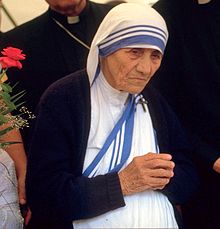 Teresa of Calcutta
Teresa of Calcutta
To enter into the “thirst of Jesus,” then, is to touch the most radical and absolute level of desire. It is to experience, not just conceptually but in the most intimate ground of one's created being, what Emmanuel Levinas called "the idea of Infinity" that awakens the most imperious desire--in his words, "not a Desire that the possession of the Desirable slakes, but the Desire for the Infinite which the desirable arouses rather than satisfies."
On the occasion of the canonization of Mother Teresa, I recommend this article by Mary Frohlich, editor of Saint Therese of Lisieux: Essential Writings. With the distinction that characterizes all her work, she explores the theme that linked Mother Teresa to her patron saint, herese of Lisieux. This article, first published in New Theology Review in November 2008, may now be read online.
Read "'The Thirst of Jesus' in the Vocations of Mother Teresa and Therese of Lisieux."
United in the bond of sainthood, may St. Therese and her newest canonized disciple continue to quench the thirst of Jesus.
See in one volume some of the texts of the saint who inspired Teresa of Calcutta:
Saint Therese of Lisieux: Essential Writings, edited by Mary Frohlich
Ordering the book here supports this Web site.
Archbishop Pontier invites all Catholics in France to a day of prayer and fasting on Friday, July 29, 2016 after the murder of Father Jacques Hamel
 Mgr Georges Pontier, archbishop of Marseille and President of the Bishops' Conference of France, invited Catholics to a day of fasting and prayer Friday, July 29.
Mgr Georges Pontier, archbishop of Marseille and President of the Bishops' Conference of France, invited Catholics to a day of fasting and prayer Friday, July 29.
“From Krakow, where I learned of the unthinkable and horrible drama of Seine-Maritime [the section of Normandy where the terrorist attack took place this morning], I want to convey to the family of Father Hamel, to the parish of Saint-Etienne-du-Rouvray, and to the Archbishop of Rouen the assurance of my closeness and my prayer and solidarity. This tragedy, which occurred in a church, shakes up and disturbs all the French people.
I thank all those who, in their diversity, have expressed their friendship to the Catholic family.
We have various feelings in such moments as these. We know, however that one of them, fraternity, dear to our country, is the way that leads to lasting peace. Let's build it together.
I invite all the Catholics of France to participate in a day of fasting and prayer for our country and for peace in the world this Friday, July 29th.
Here in Krakow, with all the French bishops present, I invite the youth of our dioceses and our movements to live the Way of the Cross with Pope Francis for this intention. We follow Christ in his victory over hatred, revenge, and death.
It is our light and hope.
Mgr Georges PONTIER
Archbishop of Marseille
President of the Bishops' Conference of France
(translated with thanks from the Web site of the Catholic Church of France).
Let's show our solidarity with the suffering people of France by joining them in this day of prayer and fasting on Friday.
To meditate on the life story of Fr. Jacques Hamel, please see "Jacques Hamel, 85, a beloved French priest killed in his church" in the New York Times.
The miracle that made Elizabeth of the Trinity a canonized saint: the healing of Marie-Paul Stevens. June 20, 2016
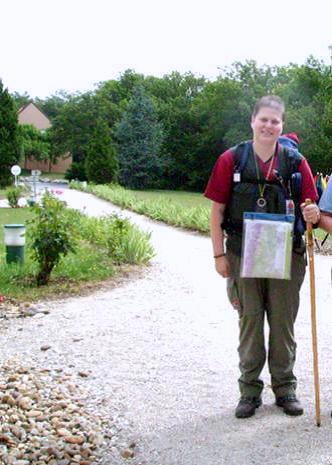 Photo of Marie-Paul Stevens, whose cure was certified as the miracle for the canonization of Blessed Elizabeth of the Trinity. Released by the Dijon Carmel June 20, 2016
Photo of Marie-Paul Stevens, whose cure was certified as the miracle for the canonization of Blessed Elizabeth of the Trinity. Released by the Dijon Carmel June 20, 2016
The story of the healing of Marie-Paul Stevens
The first photograph of Marie-Paul Stevens, the Belgian woman whose healing was accepted as the miracle for the canonization of Elizabeth of the Trinity (announced by Pope Francis today to take place on October 26, 2016) was released today by the Carmel of Dijon, with new details about her story.
Diagnosis with Sjogren's syndrome; treatment
In 1997 Marie-Paul Stevens, a Belgian woman, was a professor of religion at the Institute of the Marist Brothers in Malmedy. She was then 39 years old. In May she started to have trouble speaking and developed other symptoms. On the advice of a friend, she underwent various medical tests, and, some weeks later, was diagnosed with Sjogren's syndrome, an autoimmune disease. Her sickness advanced; the government asked her to retire early, and she had to leave her profession in 1998. Although Marie-Paul received chemotherapy and other treatment, her health grew worse. In 2000 and 2001, she became more and more disabled and was in unbearable pain.
Prayer for healing
Since her adolescence, Marie-Paul had loved Elizabeth of the Trinity and had prayed for her intercession. Now all her friends, together with the nuns of the Carmel of Dijon (now in Flavignerot, where the nuns had moved in 1979), continued to pray the novena to Blessed Elizabeth to ask for Marie-Paul's healing. The patient herself did not ask to be cured, but she wanted to go on pilgrimage to the Carmel of Flavignerot before she died to thank Elizabeth, who had accompanied her so powerfully during her illness.
The patient makes a pilgrimage of thanksgiving to pray at Elizabeth's Carmel before she dies
Accompanied by friends, Marie-Paul came as a pilgrim to the Carmel of Flavignerot. On April 2, 2002, in the chapel of the Carmel, she prayed and gave thanks to Elizabeth for sustaining her during her five-year illness. Coming out of the chapel exhausted, she sat down to rest on one of the rocks that edged the monastery's parking lot. All at once she stood up, raised her hands to heaven, and cried out in amazement and happiness "I'm not in pain any more!" From that day she has been well.
Restored to health, Marie-Paul makes a second pilgrimage of thanksgiving on foot
Just a few months later, Marie-Paul was able to walk 350 kilometers (217 miles) on a pilgrimage to give thanks. It took some time, and many medical examinations, till the happy day when, on March 3, 2016, Pope Francis authorized Cardinal Amato, prefect of the Congregation for the Causes of Saints, to promulgate the decree approving the cure of Marie-Paul Stevens as a miracle attributable to the intercession of Blessed Elizabeth of the Trinity. It was this which opened the way for Elizabeth's canonization, and Pope Francis announced today that she will be canonized on Sunday, October 16, 2016.
Blessings
Marie-Paul, we thank you for your faith and endurance, and we rejoice in your cure and in God's having chosen you as an instrument to make soon-to-be-Saint Elizabeth of the Trinity known and loved. May she accompany you more and more closely.
In the radiance of Therese: Blessed Elizabeth of the Trinity to be canonized on October 16, 2016
 Blessed Elizabeth of the Trinity January or February 1903
Blessed Elizabeth of the Trinity January or February 1903
This morning, June 20, 2016, at a public consistory, Pope Francis announced the canonization of five saints, including Blessed Elizabeth of the Trinity, a young Carmelite mystic of Dijon, France (1880-1906) who was an early and fervent disciple of Therese. Elizabeth will be canonized on Sunday, October 16, 2016 in Rome. This is a day of thanksgiving for all who love Therese.
The Canonization Miracle for Blessed Elizabeth of the Trinity
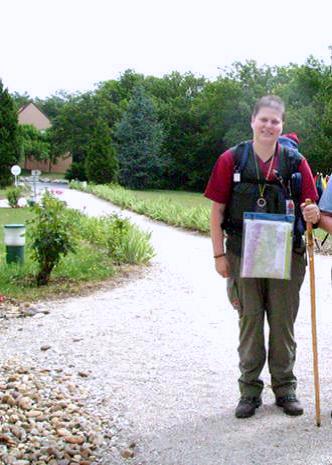 Marie-Paul Stevens, the Belgian woman whose cure was accepted as the miracle necessary for the canonization of Elizabeth of the Trinity. Photo Credit: Carmel of Dijon
Marie-Paul Stevens, the Belgian woman whose cure was accepted as the miracle necessary for the canonization of Elizabeth of the Trinity. Photo Credit: Carmel of Dijon
To know more about Elizabeth of the Trinity:
Light Love Life - Elizabeth of the Trinity: a Look at a Face and a Heart
edited by Fr. Conrad De Meester and the Carmel of Dijon; translated Sr. Aletheia Kane, O.C.D. Editorial Assistant: Fr. John Sullivan, O.C.D. A beautiful photographic album lavishly illustrated with photos of Elizabeth and her milieu, enriched with texts that will attract those new to Elizabeth and her old friends. A marvelous introduction for her new friends, a treasure for her old friends.
Two Sisters in the Spirit, by Hans Urs von Balthasar, S.J., the distinguished Jesuit theologian, shows how Therese and Elizabeth each complement the contemplative life of the other. edited by Fr. Conrad De Meester and the Carmel of Dijon; translated Sr. Aletheia Kane, O.C.D. Editorial Assistant: Fr. John Sullivan, O.C.D.
Elizabeth's Writings
Fr. Conrad De Meester, O.C.D., who has interpreted Therese so brilliantly, edited in three volumes the critical edition of Elizabeth's writings. "Vol. I: General Introduction and Major Spiritual Writings" and Volume II, Letters from Carmel have been published in English. We are awaiting publication of the third volume in English.

For a biography in English, consult He Is My Heaven: The Life of Elizabeth of the Trinity by Jennifer Moorcroft.
The Abysses of Love and Mercy of the Heart of Jesus: St. Thérèse of Lisieux and the Sacred Heart - for the feast of the Sacred Heart
The Abysses of Love and Mercy of the Heart of Jesus:
St. Therese of Lisieux and the Sacred Heart
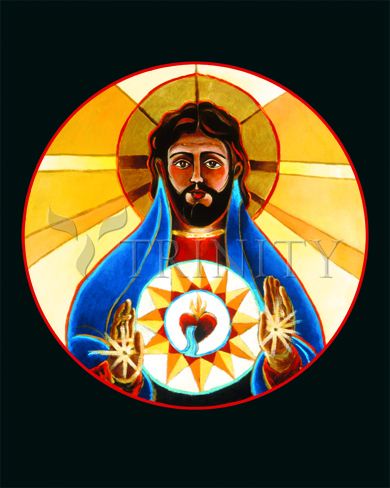 "Sacred Heart" icon by Michael O'Neill McGrath. OSFS. Available from Trinity Icon Stores.
"Sacred Heart" icon by Michael O'Neill McGrath. OSFS. Available from Trinity Icon Stores.
The devotion to the Sacred Heart in 19th-century France
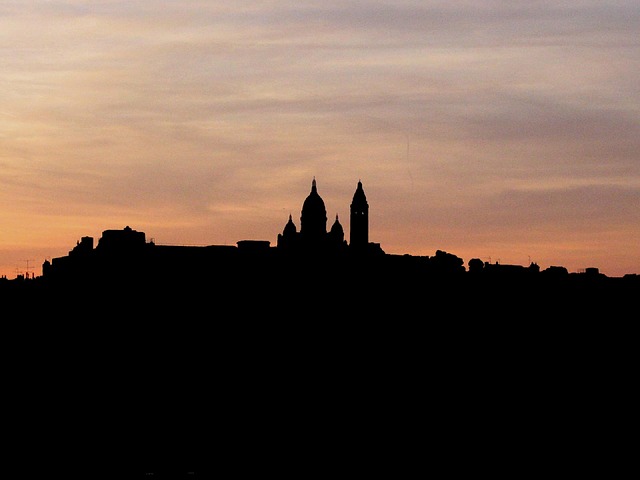 Basilica of the Sacred Heart at MontmartreThérèse Martin grew up in the Church of late 19th century France, in which the cult of the Sacred Heart was omnipresent, a cult of reparation shaped most recently by the humiliation of France during the Franco-Prussian war. Her family’s spiritual director, Father Almire Pichon, was called an apostle of the Sacred Heart. Her sister Marie took “of the Sacred Heart” as her religious name, and the Carmelite monastery Thérèse entered was dedicated to the Sacred Heart. In 1887 Thérèse participated in a pilgrimage to Rome intended to show the French church’s loyalty to the embattled Pope Leo XIII on his priestly jubilee. With the other pilgrims, before leaving Paris, Thérèse was consecrated to the Sacred Heart in the crypt of the unfinished Basilica of the Sacred Heart at Montmartre. (This text link leads to my detailed article about the events of that day). Later she sent her gold bracelet to form part of the large monstrance at the basilica. And, like all the pilgrims, she wore the badge of the Sacred Heart.
Basilica of the Sacred Heart at MontmartreThérèse Martin grew up in the Church of late 19th century France, in which the cult of the Sacred Heart was omnipresent, a cult of reparation shaped most recently by the humiliation of France during the Franco-Prussian war. Her family’s spiritual director, Father Almire Pichon, was called an apostle of the Sacred Heart. Her sister Marie took “of the Sacred Heart” as her religious name, and the Carmelite monastery Thérèse entered was dedicated to the Sacred Heart. In 1887 Thérèse participated in a pilgrimage to Rome intended to show the French church’s loyalty to the embattled Pope Leo XIII on his priestly jubilee. With the other pilgrims, before leaving Paris, Thérèse was consecrated to the Sacred Heart in the crypt of the unfinished Basilica of the Sacred Heart at Montmartre. (This text link leads to my detailed article about the events of that day). Later she sent her gold bracelet to form part of the large monstrance at the basilica. And, like all the pilgrims, she wore the badge of the Sacred Heart.
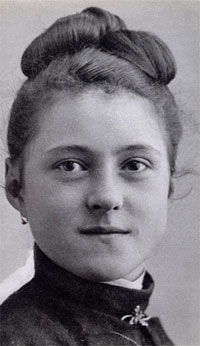 The Sacred Heart for Therese: "The Heart of my Spouse is mine alone"
The Sacred Heart for Therese: "The Heart of my Spouse is mine alone"
But Thérèse had no interest whatever in any cult of the Sacred Heart which was focused on making reparation for the outrages of sin. Nor did she relate to the Sacred Heart as a national symbol. The pilgrim Thérèse was seeking only Jesus. She appropriated the Heart of Jesus in an intensely personal and relational way. For Thérèse the Heart of Jesus is always for her, and it always seeks a response from her heart. At fifteen she called Jesus “Him whose heart beats in unison with my own.”[1] At seventeen she wrote to her sister Céline, who was at Paray-le-Monial with their sister Leonie for the second centenary of the death of then-Blessed Margaret Mary Alacoque, who received visions of the Sacred Heart:
Pray to the Sacred Heart; you know that I myself do not see the Sacred Heart as everybody else.[2] I think that the heart of my Spouse is mine alone, just as mine is His alone,[3] and I speak to Him then in the solitude of this delightful heart to heart, while waiting to contemplate Him one day face to face. . . [4]
June 1895: Merciful Love
In June 1895, the “year of the Sacred Heart” for Thérèse, she had a new experience of the heart of God:
I was thinking about the souls who offer themselves as victims of God’s Justice in order to turn away the punishments reserved to sinners, drawing them upon themselves. This offering seemed great and very generous to me, but I was far from feeling attracted to making it. From the depths of my heart, I cried out:
"O my God! Will Your Justice alone find souls willing to immolate themselves as victims? Does not Your Merciful Love need them too? . . . . On every side this love is unknown, rejected. . . . . . O my God! Is Your disdained Love going to remain closed up within Your Heart? It seems to me that if You were to find souls offering themselves as victims of holocaust to Your Love, You would consume them rapidly; it seems to me, too, that You would be happy not to hold back the waves of infinite tenderness within You.[5]
Thérèse experienced God not as outraged justice exacting atonement from her but as rejected love arousing her compassion and inviting her to be a channel of God’s infinite love to humanity.
1895: Poem "To The Sacred Heart of Jesus"
In her poem “To the Sacred Heart of Jesus,” written either in June or in October 1895 for her sister, Marie of the Sacred Heart, Thérèse returns to many of the themes of her “Offering of myself as a victim of Holocaust to Merciful Love.”[6] The editors of her poetry write:
“Thérèse does not linger over the symbol of Christ’s Heart wounded by the lance, which was so popular in her day. She goes straight to the reality: the loving Person of Jesus, his deep feelings, and the love that fills his Heart.”[7]
She speaks of the heart her own heart desires:
I need a heart burning with tenderness
Who will be my support forever,
Who loves everything in me, even my weakness…
And who never leaves me day or night.”[8]
She finds this heart in the humanity of Jesus and in the Eucharist:
You heard me, only Friend whom I love.
To ravish my heart, you became man.
You shed your blood, what a supreme mystery!...
And you still live for me on the Altar.
Deprived of palpable consolation, she can rest on the Sacred Heart:
If I cannot see the brilliance of your Face
Or hear your sweet voice,
O my God, I can live by your grace,
I can rest on your Sacred Heart!
The Heart is not a distant symbol to her: it is all her joy.
O Heart of Jesus, treasure of tenderness,
You Yourself are my happiness, my only hope.
You who knew how to charm my tender youth,
Stay near me till the last night.
She does not propitiate the Heart, but always locates herself inside it:
It’s in your ever-infinite goodness
That I want to lose myself, O Heart of Jesus!
The Heart of Jesus does not demand atonement; it simply burns with love. Faced with her human weakness and the justice of the law, Thérèse takes refuge in that heart, which not only protects her but also is itself her virtue (reminiscent of her offering of herself: “I beg You, O my God, to be Yourself my Sanctity!”[9]):
Ah! I know well all our righteousness
Is worthless in your sight.
To give value to my sacrifices,
I want to cast them into your Divine Heart.
I do not fear, my virtue is You!...
You did not find your angels without blemish.
In the midst of lightning you gave your law!...
I hide myself in your Sacred Heart, Jesus.
Thérèse’s confidence reaches its height in her daring prayer choosing the Heart of God as her purgatory and asking to go straight to the Heaven of that Heart:
To be able to gaze on your glory,
I know we have to pass through fire.
So I, for my purgatory,
Choose your burning love, O heart of my God!
On leaving this life, my exiled soul
Would like to make an act of pure love,
And then, flying away to Heaven, its Homeland,
Enter straightaway into your Heart.
In another poem she wrote in October 1895, she audaciously prays to love Jesus with His own heart:
Remember that on earth I want
To console you for the forgetfulness of sinners.
My only Love, grant my prayer.
Ah! give me a thousand hearts to love you.
But that is still too little, Jesus, Beauty Supreme.
Give me your divine Heart Itself to love you.[10]
Several months later she again appropriates the Heart of her Spouse “to love more tenderly.” She writes to her Visitandine sister Léonie:
Dear Sister, I love you a thousand times more tenderly than ordinary sisters love each other, for I can love you with the Heart of our celestial Spouse.[11]
Far from demanding reparation, the Heart of Jesus (“more than maternal”) repairs us. In 1896 Thérèse writes that this heart “restores innocence:”
O you who knew how to create the mother’s heart,
I find in you the tenderest of Fathers!
My only Love, Jesus, Eternal Word,
For me your heart is more than maternal.
***
Your heart that preserves and restores innocence
Won’t betray my trust![12]
Thérèse writes often of “resting” or “sleeping” on the heart of Jesus
And if sometimes Jesus sleeps,
You will rest beside Him.
His Divine Heart that always keeps vigil
Will serve as your sweet support.[13]
The little child . . . sleeps always on the Heart of the Great General. Close to this Heart, we learn courage, and especially confidence.[14]
June 1897: the Heart of Jesus and the heart of Mary Magdalene
Three months before her death, writing to Maurice Bellière, the seminarian who was her spiritual brother, Thérèse gives her most powerful witness to her experience of the Heart of Jesus:
When I see Magdalene walking up before the many guests, washing with her tears the feet of her adored Master, whom she is touching for the first time, I feel that her heart has understood the abysses of love and mercy of the Heart of Jesus, and, sinner though she is, this Heart of love was not only disposed to pardon her but to lavish on her the blessings of His divine intimacy, to lift her to the highest summits of contemplation.
Ah! dear little Brother, ever since I have been given the grace to understand also the love of the Heart of Jesus, I admit that it has expelled all fear from my heart. The remembrance of my faults humbles me, draws me never to depend on my strength which is only weakness, but this remembrance speaks to me of mercy and love still more.[15]
On July 17, 1897 she ends her last letter to Léonie, promising to be her sister’s messenger to the Sacred Heart:
You want me to pray in heaven to the Sacred Heart for you. Be sure that I shall not forget to deliver your messages to Him and to ask all that will be necessary for you to become a great saint.[16]
The next day Thérèse writes once more to Maurice Bellière about the heart of Jesus. For more than a century her message has echoed in the heart of humanity, as it echoes today:
Ah! how I would like to make you understand the tenderness of the Heart of Jesus, what He expects from you![17]
______________________________
[1] Excerpt from LT 67, letter from Thérèse to her aunt, Mme. Guerin, November 18, 1888. Letters of St. Thérèse of Lisieux, Volume I, 1877-1890, tr. John Clarke, O.C.D. Washington, D.C.: ICS Publications, 1982, p 478. The next three notes are drawn from that work.
[2] “Crowned with thorns, with a big cross set up in the center,” as Sister Marie of the Sacred Heart wrote to Celine on October 13, quoting P. Pichon.
[3] See Canticle of Canticles 2:16.
[4] Excerpt from LT 122, letter from Thérèse to Cèline, October 14, 1890. The second centenary of Blessed Margaret Mary’s death, October 17, 1890, attracted crowds to Paray-le-Monial. Letters of St. Thérèse of Lisieux, Volume II, 1890-1897, tr. John Clarke, O.C.D. Washington, D.C.: ICS Publications, 1988, pp. 709-710.
[5] Story of a Soul: The Autobiography of St. Thérèse of Lisieux, tr. John Clarke, O.C.D., 3rd edition. Washington, D.C.: ICS Publications, 1996, pp.180-181.
[6] This prayer is often called the “Act of Oblation to Merciful Love,” but Thérèse never called it that. She titled her manuscript "Offering of myself as a Victim of Holocaust to the Merciful Love of God."
[7] PN 23, Introductory notes to “To the Sacred Heart of Jesus,” June or October 1895, in The Poetry of Saint Therese of Lisieux, tr. Donald Kinney, O.C.D. Washington, D.C.: ICS Publications, 1996, p. 117.
[8] PN 23, “To the Sacred Heart of Jesus,” June or October 1895, in The Poetry of Saint Therese of Lisieux, ibid., pp. 117-120.
[9] Story of a Soul, op. cit., p. 276.
[10] PN 24, “Jesus, My Beloved, Remember!” October 21, 1895. The Poetry of Saint Therese of Lisieux, op. cit., p. 130.
[11] LT 186, from Thérèse to Léonie, April 11, 1896. Letters, Volume II, op. cit., p. 951.
[12] PN 36, “Jesus Alone,” August 15, 1896. The Poetry of Saint Therese of Lisieux, op. cit., p. 165.
[13] PN 13, “The Queen of Heaven to her Beloved Child Marie of the Holy Face,” December 25, 1894. The Poetry of Saint Therese of Lisieux, ibid., p. 78.
[14] LT 200, from Thérèse to Sister Marie of St. Joseph, end of October 1896? Letters, Volume II, op. cit., p. 1013.
[15] LT 247, from Thérèse to abbé Bellière, June 21, 1897. Letters, Volume II, ibid., p. 1133.
[16] LT 257, from Thérèse to Léonie, July 17, 1897. Letters, Volume II, ibid., p. 1149.
[17] LT 258, from Thérèse to abbé Bellière, July 18, 1897. Letters, Volume II, ibid., p. 1152.




